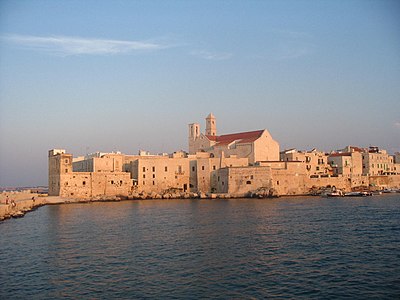GIOVINAZZO
Giovinazzo is a splendid and
evocative suburb facing the Adriatic coast, already known
by the Romans by the name of Natiolum, perhaps risen out of
the ruins of an ancient Peucezio centre which was brought
to the ground during the Punic Wars (III Century BC).
Legend instead wants its foundation to be by the hand of Perseo
(Perseus), son of Zeus, who named it Jovis Natio.
During the Imperial era, the centre grew due to its natural
position near to the Via Traiana route (constructed between
108 and 110 AD).
The very same Traiano Emperor had it fortified in 102.
It was among the first localities in Puglia to be converted
to Christianity, as Giovinazzo already had many churches spread
over its territory during the era at the end of the Roman
Empire.
In 550 it became an Episcopal seat, therefore acquiring further
importance.
During the High Medieval period (7th Century), the suburb
changed name to Juvenatium, that is Juvene Natiolum, signifying
a discontinuity with the old suburb, probably destroyed during
invasions by the Visigoths, Vandals and Ostrogoths (5th Century
AD).
It passed over to Byzantines from the Roman Western Empire,
and Juvenatium experienced alternating rule from the Longobards
and Byzantines, as well as Saracen incursions (9th and 10th
Centuries).
With the arrival of the Normans during the 11th Century, the
suburb transformed its city plan with the construction of
the Cathedral (12th Century), dedicated to Saint Maria Assunta,
other churches and noble dwellings of great beauty; testifying
a period of enrichment in the suburb.
With the advent of the Angioini (13th Century) and their bad
governing, Giovinazzo experienced a period of economic decline,
only interrupted with the arrival of the Aragonese during
the 15th Century.
In 1521, Emperor Carlo V sold it to Don Ferrante of Capua,
Duke of Termoli.
It then became a feudatory of the Gonzaga Family, who governed
it for more than a century, finally surrendering it in 1639
to Domenico Giudice, Prince of Cellamare. The Giudice Family
remained until 1770, after which Giovinazzo passed under direct
Bourbon rule, who had visited the City in 1797.
In 1860, Giovinazzo, took part in the plebiscitary vote, which
sanctioned its annexation and that of all of Puglia, to the
Reign of Italy (1861).
A visit to Giovinazzo, remains in the heart of more sensitive
visitors, touched by the charm of its marine vocation and
by the architectonic beauty in the heart of its suburb.
One can enter the suburb through the Traiano Arch, which encompasses
four varying marine columns from the old Via Traiana. From
here, one can reach the Romanesque Cathedral, a true gem of
Romanesque architecture, which preserves precious works of
art and frescoes in its interior.
Near to the Duomo, one can admire some splendid buildings:
Palazzo Framarino Malatesta (14th-19th Century), Palazzo Vescovile
(14th-15th Century), Palazzo Ducale (1657) and not too far
away, Palazzo Lupis (13th Century).
Among the Churches to visit in the suburb: the Madonna of
Constantinople, with a stone sculpture of S. Cristoforo (Saint
Christopher), S. Carlo, S. Maria of Carmine, the beautiful
Santa Maria degli Angeli (Saint Maria of the Angels - 1200),
S. Felice, S. Giovanni Battista (S. John the Baptist), the
Spirito Santo (Holy Spirit - 1395), S. Lorenzo.
|
